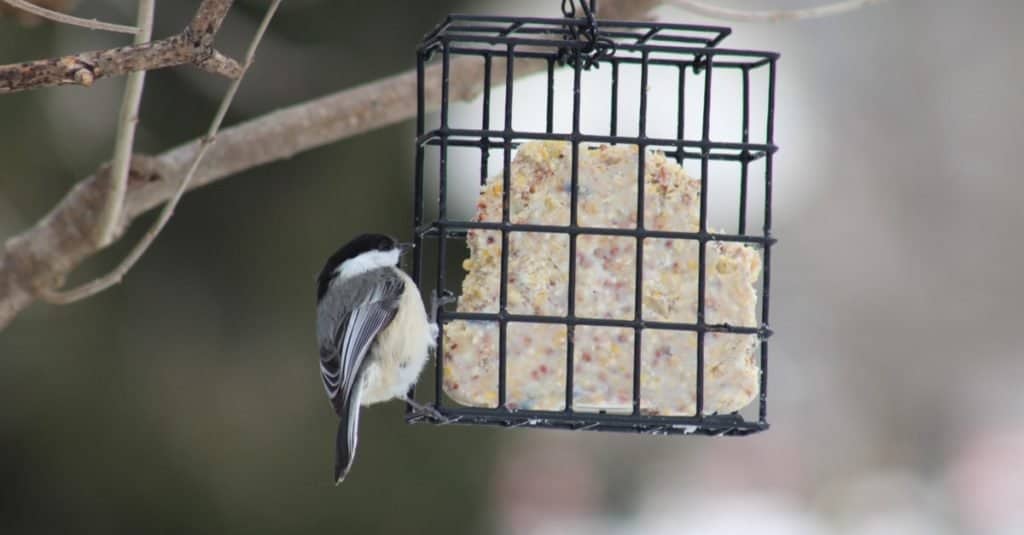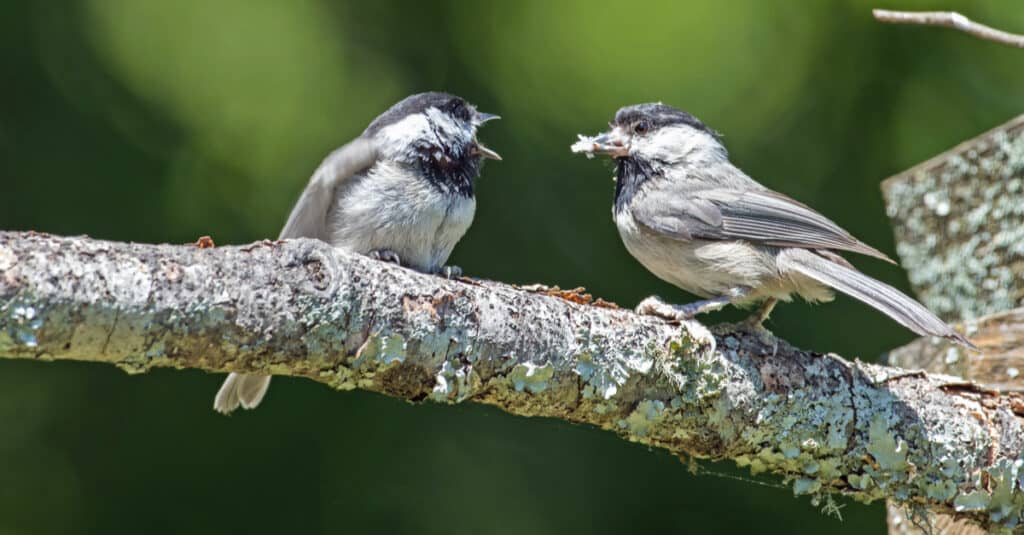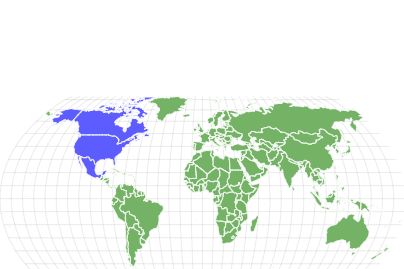Chickadee
Chickadees are named for the sound they make: Chick-a-dee-dee-dee-dee-dee!
Advertisement
Chickadee Scientific Classification
Read our Complete Guide to Classification of Animals.
Chickadee Conservation Status
Chickadee Facts
- Prey
- Insects
- Fun Fact
- Chickadees are named for the sound they make: Chick-a-dee-dee-dee-dee-dee!
- Estimated Population Size
- 43 million
- Biggest Threat
- Habitat loss
- Most Distinctive Feature
- "Cap" of dark feathers on head
- Other Name(s)
- Tit, titmous
- Wingspan
- 6 to 8 inches (15 to 20 cm)
- Incubation Period
- 12 days
- Litter Size
- 4 to 8
- Habitat
- Open woodland
- Predators
- Birds of prey
- Diet
- Omnivore
- Favorite Food
- Insects, seeds
- Type
- Bird
- Common Name
- Chickadee
- Number Of Species
- 7
- Location
- North America
- Nesting Location
- Tree Cavity
- Age of Molting
- 10 days
View all of the Chickadee images!
“Chickadee species are named for their plumage, their location, and their warning call or song.”
Chickadees are a familiar North American feeder bird. They can be seen in backyards across the continent, making “fee-bee” and “chick-a-dee-dee-dee” songs and sounds. These friendly birds are easily recognized by their striking black and white markings. The variations between species are subtle – can you tell them apart?
4 Amazing Chickadee facts!
- The “chick-a-dee-dee-dee” sound made by these birds is an alarm call. Their normal song sounds like “fee-bee.”
- The number of “dees” in the alarm call is used to identify the predator. Other bird species also understand the meaning.
- The grey-headed chickadee is found in both North America and Eurasia. In the latter, it is called the Siberian tit.
- Unlike other birds, these birds will not reuse an old nest. They build a new one for each brood, up to two per year.

Where To Find Them
These birds are common throughout North America, from the east coast to the west coast and from Canada to northern Mexico. Their preferred habitat is mixed deciduous and coniferous forests, but they have adapted well to parks and neighborhoods.
The black-capped chickadee spans southern Canada and the northern United States, while the Carolina chickadee occupies the southeastern United States. Mountain chickadees can be found from the Rocky Mountains to the west coast. Boreal chickadees live in Canada, and chestnut-backed chickadees reside on the continent’s Pacific coast. The Mexican chickadee can be found in Arizona and New Mexico. The grey-headed chickadee is a holarctic species, meaning it is found throughout the northernmost reaches of the world’s northern continents.
You can attract these birds to your own backyard. If you put out a seed feeder, they are sure to arrive daily. You can also mount a birdhouse on a tree to encourage them to nest nearby.
Nests
These birds are cavity nesters. They like to build nests in tree holes or similar structures, such as a birdhouse, located 10 to 15 feet off the ground. Often, pairs will excavate several potential nest sites before selecting the one they will use. They nest in the tree’s soft, rotten wood, building a nest of moss and soft materials over the course of several days. Nesting season runs from April through June each year.
Scientific Names
There are seven species of these birds in North America. They belong to the genus Poecile of the family Paridae, order Passeriformes. There are also similar-looking members of this genus in Europe. There, however, they are called tits or titmice rather than chickadees.
Some of the most common chickadee species include:
- Black-capped Chickadee (Poecile atricapillus) – The Black-capped Chickadee is named for its striking color pattern. It has a black head and neck, with white patches on the sides of the face. Its back, wings, and tail are gray with black and white markings. Its belly is white with reddish-brown patches near the wings. Their range stretches north to Alaska and Canada, south to New Mexico, west to California, and east to New York.
- Boreal Chickadee (Poecile hudsonicus) – This particular bird has a colorful brown cap and gray body, black bib, and also white cheeks. They can be found near in the upper United States and also in Canada in forests that have fir and spruce.
- Carolina Chickadee (Poecile carolinensis) – These chickadees look similar to their black-capped cousins, except they have wings with a bit more brown in them. You can find them in lower altitudes of deciduous and mixed forests the United States from Florida, to New Jersey and as far West as Texas.
- Chestnut-backed Chickadee (Poecile rufescens) – One of the smaller of their breed, they measure under 5 inches, and their heads have very dark brown look but with white cheeks. Their mantle, however, brightens up a good bit to have a striking brown color and makes them one of the more handsome chickadees. They can be found It is found in the Pacific Northwest.
- Grey-headed Chickadee (Poecile cinctus) – One of the larger chickadees, while they are have grey in their name, they actually have black, brown, and white feathers on them. They can be found in northwestern Canada and Alaska.
- Mexican Chickadee (Poecile sclateri) – These are another chickadee that favors the Black-capped version, but they can be told apart by their longer black bib. Look for them in Mexico, New Mexico, and Arizona.
- Mountain Chickadee (Poecile gambeli) – What distinguishes these from other chickadees in appearance is the white line on their cap, instead of a solid black cap. They are located in generally the great Rocky Mountain surrounding area.
In addition to the seven species, the genus Poecile contains eight tits, totaling 15 species.

Chickadees belong to the genus
Poecileof the family Paridae and order Passeriformes.
©Rob Palmer Photography/Shutterstock.com
Size, Appearance, & Behavior
All species have a distinctive appearance, grey coloration with, black, and sometimes rosy markings. One of the most common species is the black-capped chickadee. It is 5 inches (12 cm) long, with a dark cap and bib, for which it is named. A few species, such as the chestnut-backed chickadee, have prominent reddish-brown markings. The smallest is only 2.4 inches (6 cm) long.
In the fall and winter months of August through February, these birds gather in small flocks. These may include other types of birds, including downy woodpeckers, nuthatches, and tufted titmice. As spring arrives, couples break away from the flocks in order to mate and raise their young. These birds do not migrate but stay near their breeding grounds year-round.
These birds maintain their body temperature during cold weather by fluffing their feathers and restricting blood flow near the skin. On very cold nights, they survive by entering a state called torpor – a type of suspended animation in which the metabolism slows down and the body temperature drops by about 10 degrees. The “frozen” birds wake up when temperatures rise.

s do not migrate but stay near their breeding grounds year-round.
©Danita Delimont/Shutterstock.com
Diet
Because of their diet, these birds are a sure bet for your birdfeeder. At a feeder, they often take turns, feeding one at a time. They also have a unique behavior called caching – they store food in crevices or under twigs. They may return to it up to a month later.
These birds often form “bird guilds,” foraging in a flock with several other species. These birds get along because they all hunt for food in different ways. The chickadees in the flock become excited when a tasty morsel is found and concentrate their efforts on that location.
What Do They Eat?
These birds love to eat seeds, insects, and berries. During the nesting season, they also consume insect larvae and eggs. Fifty to 80 percent of their diet consists of insect protein.

Because of their diet, chickadees are a sure bet for your bird feeder.
©Wade Lamb/Shutterstock.com
Predators and Threats
As a small birds, they must look out for predators from above. These include shrikes, hawks, and owls.
Eggs and baby birds are most at risk from tree-climbing mammals such as cats and raccoons. Snakes are also a danger. The fact that these birds prepare multiple nest sites helps them avoid predators. If a predator finds their nest, it will build another some distance away.
What Eats Them?
Birds of prey are most likely to hunt adults. Cats are another common predator.
Reproduction, Babies, and Lifespan
These birds do not have elaborate mating rituals, but males will attempt to chase rival males from their territory. After selecting a nest site, the female lays six to eight white, speckled eggs. She incubates the eggs for about 12 days while the male brings her food.
Once a baby hatches, the female will continue to warm it constantly for several days. Both the male and female birds feed the young, which leave the nest after 16 days. Only 20 percent of chickadee chicks survive their first year.
These birds typically have a lifespan of two to three years, but they can live much longer. In 2011, a bird was recaptured that had been banded nine years earlier. It was thought to be two years old when banded, reaching a full age of eleven and a half years.

Black-Capped Chickadee feeding its chick.
©Tom Franks/Shutterstock.com
Population
While exact numbers of black-capped, Carolina, boreal, and other chickadee species are unknown, backyard bird counts in recent years indicate that their population is on the rise. Populations decreased in the early 2000s due to the West Nile virus, but have rebounded in recent years. The bird’s conservation status is unlisted or unknown; it is not currently an animal of concern.
View all 235 animals that start with CChickadee FAQs (Frequently Asked Questions)
What Birds Are Similar to Chickadees?
In North America, downy woodpeckers and tufted titmice are of a similar size and often socialize and feed with chickadees. In Europe, similar birds of the same genus include tits and titmice – the willow tit, Caspian tit, Sichuan tit, marsh tit, black-bibbed tit, Pere David’s tit, sombre tit, and white-browed tit. Another group of birds that’s often confused with chickadees are sparrows. The key differences between the two are that sparrows are larger with a more elongated body.
Where Do Chickadees Live?
Chickadees live in forests, backyards, and parks across North America. Their range extends from southern Canada to northern Mexico, and from coast to coast. The grey-headed chickadee also has a range in Eurasia, where it is called the Siberian tit.
How Big Are Chickadees?
Chickadees are small birds. They range from 2.5 to 6 inches in length.
Do Chickadees Migrate?
No. Chickadees overwinter in their home ranges, meaning they can be observed year-round.
How Many Eggs Do Chickadees Lay?
Chickadees typically lay between 5 and 8 eggs per clutch.
How Fast Do Chickadees Fly?
A black-capped chickadee’s flight speed is 12 miles per hour (20 km/h).
What Is a Chickadee's Wingspan?
Chickadees have a wingspan of 6 to 8 inches (15 to 20 cm).
When Do Chickadees Leave the Nest?
Baby chickadees leave the nest about 16 days after hatching.
What are the differences between a chickadee and a junco?
The greatest differences between a junco and a chickadee include their morphology and location.
What are the differences between a chickadee and a nuthatch?
The greatest differences between a nuthatch and a chickadee include their morphology and size.
Other differences are dietary habits, color, and unique body type.
Thank you for reading! Have some feedback for us? Contact the AZ Animals editorial team.
Sources
- Britannica, Available here: https://www.britannica.com/animal/chickadee
- Wild Bird Watching, Available here: https://www.wild-bird-watching.com/Chickadees.html#:~:text=After%20brooding%2C%20both%20the%20male,no%20longer%20feed%20their%20offspring.
- Wikipedia, Available here: https://en.wikipedia.org/wiki/Chickadee
- Reader's Digest. (1970) Book of North American Birds.
- The National Wildlife Federation Contact Us Blog Shop Log In Search for..., Available here: https://www.nwf.org/Educational-Resources/Wildlife-Guide/Birds/Black-Capped-Chickadee

















